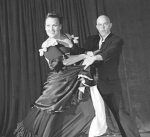▼
Crossing Into The Unknown with Wine, Cheese and Music ◆ by Brenda McNellen and Kristen Strandberg
In the past, high-end restaurants like Eleven Madison Park in New York City have encouraged the transcendence that can come from focusing on one sense at a time; fully engaging with the spirit of the food by isolating it from the realm of the everyday. Its menu was a model for controlled experiences: a minimalist grid that looks almost like a periodic table, isolating each ingredient of a meal. The diners would select four elements they wanted and the chef would prepare a meal incorporating these as the center of each course. This mindfulness about food spread to other parts of the diner’s experience—serious diners would limit the amount of conversation during meals in order to focus on the food. Classical music resided in a similar realm—during the late 18th century a hush descended upon audiences when the culture of listening changed to include expectations of absolute quiet during performances and restricting applause to the correct places in a performance in order to avoid breaks in focus. In many classical performances today, this tradition of a purely musical focus continues: consider the outburst of anger by the New York Philharmonic’s audience members and conductor, who stopped a 2012 performance when a patron’s cell phone rang during Mahler’s Ninth Symphony.
Demand for multi-sensory experiences however, is increasing, even in the realms of classical music and food. This past August, the Cincinnati Symphony performed a free outdoor concert with images and 3D animation projected onto the front of its home building, accompanied with music by Tchaikovsky, Ravel and Strauss. In a move that shocked the restaurant world, Daniel Humm and Will Guidara of Eleven Madison Park announced in 2012 that the restaurant would be doing away with its grid menu in favor of a four-hour narrated meal encompassing the history of New York and including visuals such as a cheese course hidden inside a picnic basket, and a magic trick predicting the dessert. There was a lot of buzz about this change. Would Eleven Madison Park stay in business if diners had to commit to a four-hour meal experience? Would patrons see this change as a kitschy degradation of the dining experience? Would its ranking as number 10 in the prestigious World’s 50 Best Restaurants list be jeopardized?
As with Eleven Madison Park’s announcement, most of these changes, sometimes couched in terms of attracting a new generation to participate, are often met with a good deal of skepticism. What could happen if experiences become meaningless because of all this sensory overload? In an April Fool’s day post about the Jacobs School of Music from 2009, the school is (falsely) reported to have hired popular violinist Andre Rieu and installed in the Musical Arts Center a “new jewel-studded shell, incorporating festive colors, over 5,000 energy-efficient twinkling LED lights, and several dozen miniature mirrors with gilded Rococo frames, . . . [and] a mechanized chandelier, capable of ascending and descending in under seven seconds.”
But what if these combinations can actually enhance or reframe our experiences? In Hallucinations, by Oliver Sacks (which made New York Times critic Michiko Kakutani’s 10 Favorite Books of 2012), the author discusses sensory deprivation as an aid to altering experience, but also includes the epiphanies produced by experiences in combination. He mentions being unable to remember how the color indigo really looked to him until it reappeared to him at a musical concert in the Metropolitan Museum of Art: “a Monteverdi piece was performed, and I was utterly transported. I had taken no drugs, but I felt a glorious river of music, four hundred years long, flowing from Monteverdi’s mind into my own. In this ecstatic mood, I wandered out during the intermission and looked at the ancient Egyptian objects on display—lapis lazuli amulets, jewelry, and so forth—and I was enchanted to see glints of indigo. I thought: Thank God, it really exists!” (Sacks, 110-111)
In a quest to find out how those around us felt about multisensory experience in the realms of taste and music, we interviewed some well-known Bloomingtonians that were likely candidates for immersion in these types of experiences. We wanted to know whether the mingling of senses was a distraction for them or an integral part of broadening the mind and remembering experiences.
Patricia Stiles, IU Jacobs School of Music professor and renowned opera singer who has performed in the Kennedy Center and opera houses across Europe, describes how for her, as a performing opera singer, music was almost never experienced in isolation from touch, smell, and taste. As a performer, Stiles said, the tactile experience of singing in an opera–the smells and feelings of being onstage—were inseparably linked to her experience of the music. “That’s the thing about opera,” she says, “it’s everything at once. Even the smell–there are a lot of different smells you would like to forget from the other people who have worn the costume, the sweat . . . and that’s part of the experience.” She recalls love scenes in which the singer opposite her was drenched in sweat, and says that this changes the experience of the music for her, and becomes a part of her sensory experience as a whole. Costumes bring a similar tactile element to the production. She says that “the sensory feeling of the costumes and the whole look of the stage goes a lot with music for me. The physical feeling of the costumes . . . [provide] a tactile sensation, and even the rustling sound when you move . . . it has a life of its own.”
One of Stiles’s most memorable costumes was that of a tree/human hybrid in a production of Wagner’s Das Rheingold in Germany. She describes a bizarre ensemble that included fake tree limbs with leaves on her arms and head, high heels, and very realistic fake bare breasts. She says that felt very odd, but was also liberating and fun to have such a bizarre costume that so drastically changed her appearance. She felt that she was transformed by the costume when onstage and will always remember the shift in perception that came from the feeling of wearing that costume in combination with performing the role of Erda, goddess of the earth.
For Jeffery Schauss, who is married to Patricia Stiles and also a wine buyer for Sahara Mart, analogous experiences like tasting wine and listening to music inform how we think about and describe them. Within both tasting and listening experiences there are layers of complexity. Individual wine tasters may focus on texture, flavor notes, or unexpected combinations of tastes that change from moment to moment as music listeners may focus on rhythms, harmony, sudden key or chord changes, or repeated patterns in music.
Schauss looks for balance in pairing wine with food or music, as he recommends that one sense not overpower another when layering sensory elements, even within a single sensory experience. Cheaper wines, he says, possess one “note” or category of flavor that often takes over the taste of the wine, such as fruity, floral, or nutty. By contrast, a higher-end wine “is like a symphony,” says Schauss, “it just keeps working,” as the taste evolves and changes over time. Along with the taste itself, texture also plays a role in Schauss’s experience with wine. While acknowledging that each person’s experience will be different, he says: “My mind goes more to that symphony . . . [or] to that velvet–not so much red raspberry or black cherry.” Schauss considers texture, complexity, and layers, while sometimes describing the wine to customers in tactile or aural terms.
Dmitri Vietze, the director of Rock Paper Scissors, a Bloomington company that nationally markets and publicizes world music ensembles, feels that music and food are each accessible introductions to different types of people and cultures. He says, “People are trying to get a sense of who they are through understanding who other people are, and also expand the horizons of their own identity by experiencing other tastes, whether it’s musically or culinarily . . . it’s that diversity of options and opportunity that marks the era that we live in.” Similar to the complex wines referenced by Schauss, one of the main attractions of world music is its combination of familiar musical elements with unexpected sounds, rhythms and patterns that grab the attention of listeners. The most frequent tactile sense associated with music, says Vietze, is not the taste of food or wine, but the feel of dance, including a heartbeat and moving body along with “the nervousness and the sexuality . . . the relationships, and the happiness” when music and dance are combined.
For Vietze as well as Stiles, a combination of sensory elements is what distinguishes unforgettable memories. One of his own most vivid memories stems from the day of his daughter’s birth. “It was raining when my wife went into labor so there was the smell of rain. We played music in the early stages of labor . . . by Ayub Ogada, a Kenyan singer who also plays a little traditional lyre and taps his feet with jingles on his ankles.” Vietze says that whenever he hears that music, “the rain, the smell, the music, the new hope and innocence of a new baby come right back to me.”
But is it possible to deliberately create these unforgettable memories for people with different sensory preferences by combining smell/taste/touch, and hearing/sight, in the way of Eleven Madison Park? Christine Buras, opera singer from the Jacobs School of Music and wine and cheese buyer for Bloomingfoods, thinks that while focus on certain aspects of the tasting experience are important, multi-sensory experiences can and should be constructed to deepen our enjoyment and understanding.
Buras remarks that getting customers to try a type of cheese may often entail convincing them to favor one sense over another. “Cheese doesn’t taste the way it smells. One of the smelliest cheeses we have is Taleggio, which is an Italian cow’s milk, soft-rind cheese, and it’s a pink, washed-rind cheese, cured in beer or wine. When you think of smelly, ugly cheeses, this is definitely in that category—it has green and white mold all over it normally, but the cheese inside is very mild, milky, clean and delicious. We don’t advise that people eat the rind. You would have to close your mind to the look and the smell of the outside, and open it to the taste of the cheese inside.” Very often, however, the texture of a cheese will complement the taste—people who know a lot about cheese will come in and ask for an aged cheddar or gouda with more granularity, which makes it crumbly.
As someone whose life revolves around wine, cheese, and music, Buras naturally thinks of ways to bring the three together. We asked her how she might create a beginning-to-end-of-evening experience with these three elements and she created a specific plan. She would start with something “light and playful and spontaneous,” with a white wine, as moving from lighter to heavier is a good rule of thumb. She would pair the wine with a fresh goat cheese or Saint-André, a French triple-crème cheese. Buras suggests the piano music of French composer Erik Satie for this course, as it is fun and quirky without being intrusive.
For a second course of cheese, wine, and music, Buras recommends a full-bodied red wine such as a Malbec with Old Amsterdam (an aged Gouda), or an aged Cheddar or Gruyère. The aged Gruyère, she notes, is something “we don’t see a lot of in Bloomington, but it’s worth finding.” As an after dinner course, Stilton is often paired with Port. Some Stiltons have holes drilled in them and are then soaked in a ruby port. “By the time you get to that you’re fully into British culture,” says Buras, so she would pair it with Howells organ music, Elgar, Vaughn Williams— “something with really lush chords.” For the wine, she recommends a fruity red such as a Zinfandel or Port.
While we may be losing the intensity of focus on one sense in realms like classical music and food (that have often tried to keep these experiences pure at their most elite levels), the trend of creating indelible memories by experimenting with new combinations of sensory experiences will probably be too great for most customers to ignore. What happened to Eleven Madison Park after their change to a four-hour experience menu? They jumped from number ten to number five on the World’s 50 Best Restaurants list and business is booming. The World’s 50 Best Restaurants website calls it “a dining experience that is as delightful as it is engaging.” Perhaps an “engaging” experience is just what diners and concert-goers are looking for, as multi-sensory stimulation is becoming the norm, creating new experiences with innovative combinations of existing elements. Can’t afford the trip to New York and the $200 meal at Eleven Madison Park? We hope that you take inspiration from them by experimenting with your own memorable combinations.
The Ryder ◆ November 2013










